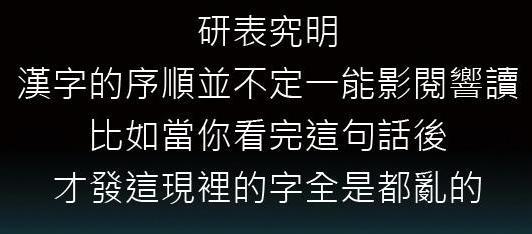Jumbled Chinese
Language Log 2013-04-13
I knew it wouldn't be long before someone came up with a Chinese equivalent to alphabetical typoglycemia:
The text reads:
Yán biǎo jiū míng Hànzì de xù shùn bìng bù dìng yī néng yǐng yuè xiǎng dú. Bǐrú dāng nǐ kàn wán zhè jù huà hòu cái fā zhè xiàn lǐ de zì quán shì dōu luàn de.
研表究明 漢字的序順並不定一能影閱響讀 比如當你看完這句話後 才發這現裡的字全是都亂的
Without rearranging, this makes little sense (except the third line, which is in the correct order).
Here are all four lines in the correct order:
Yánjiū biǎomíng Hànzì de shùnxù bìng bù yīdìng néng yǐngxiǎng yuèdú. Bǐrú dāng nǐ kàn wán zhè jù huà hòu cái fāxiàn zhèlǐ de zì quándōu shì luàn de.
研究表明 漢字的順序並不一定能影響閱讀 比如當你看完這句話後 才發現這裡的字全都是亂的
Studies have shown that the order of Chinese characters does not necessarily affect reading. For example, after you've read this sentence, you'll realize that the characters are all completely disordered.
The is indeed curious, but I wouldn't say that "the characters are all completely disordered", since in this text of 40 characters, there are only 6 instances where the order of the characters has been changed. Moreover, the only type of change employed is simple inversion of characters that are parts of well-established disyllabic terms. This is really quite tame in comparison with the more extreme kinds of typoglycemia that may be applied to writing in English.
I wonder what would happen if we started moving strokes around within characters, which might be a better analogy to typoglycemia in English.
[A tip of the hat to Yuanfei Wang for sending me the text; thanks to Gianni Wan and Fangyi Cheng]
